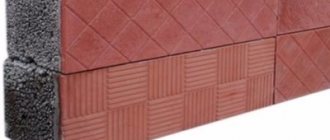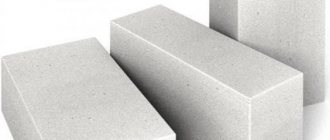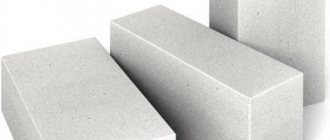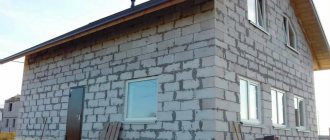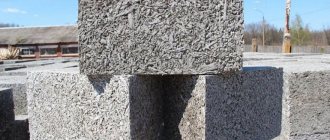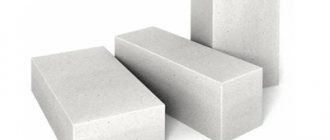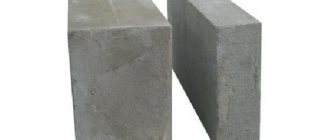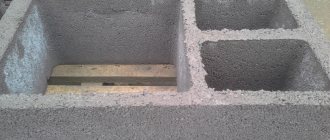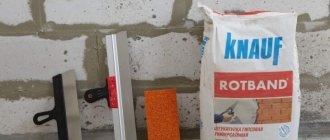Pseudo-professionals and construction amateurs often claim that aerated concrete blocks are a toxic material, and the harm they cause to the health of people prone to allergies can be significant. As a rule, such statements come from people who do not take the trouble to understand the issue, but simply express someone else’s point of view (we will modestly keep silent about competition). But since such an opinion exists, the question about the gas block: is it harmful or not, requires an intelligible answer.
Harmful or not
Aerated concrete is increasingly gaining space in the construction market.
It is lightweight, easy to use, installation in blocks occurs quickly, which saves time and, accordingly, finances; it is probably impossible to find a material with such low thermal conductivity indicators. But today, more than ever, the issue of ecological housing is becoming relevant.
We try to surround ourselves with objects made from natural materials, and the choice of building materials is also subject to increased demands. The health of our children and ourselves will depend on this.
There are regulatory documents that set out certain requirements. These requirements must be observed when designing houses of various kinds and when choosing building materials. For the construction of residential buildings, office and industrial premises, materials that meet all standards must be used.
Is there any harm?
The saying that only wooden houses are safe is not entirely correct. Knowing nothing about aerated concrete, the idea was that it is a material made from aluminum and lime, and it is unknown how it will affect health. Of course, both alyu and lime itself are unsafe in normal use.
To produce aerated concrete, four components are taken, these are natural components: Portland cement, fine-grained quartz sand, water, aluminum, lime. Porosity is formed as a result of a chemical reaction; aluminum (powder) is used as a gas generator. Hydrogen released during the reaction swells the solution. Thus, alumina oxide appears. At this time, the mixture increases in volume due to the appearance of empty cells.
For a material to become strong, it needs to harden. Manufacturers use two methods in which the material hardens:
- Autoclave method, the material is placed in a device where it is processed with high pressure and steam.
- Non-autoclave method, processing occurs only with high pressure.
As you know, the safest for health is alumina oxide. If we compare aerated concrete with brick, the latter contains almost 8 times more aluminum. Its share in aerated concrete is 0.1%. As for lime, the reaction turns it into potassium silicate.
The material is also fireproof, as tests have shown. The radiation background, which is present in all materials, does not exceed the required value. Thus, it is significantly lower than that of reinforced concrete products.
Do aerated concrete walls affect the humidity level inside the house? Aerated concrete will absorb moisture at high humidity and only if the walls are not lined. The surface of walls made of any material must be primed, plastered or lined. You can look at the finishing of walls made of aerated concrete and the interior finishing of walls made of foam concrete in other articles on our website. The indoor humidity is affected by the ventilation and heating systems.
Sometimes unscrupulous manufacturers can add slag and ash to the aerated concrete mixture. They are the ones that can be dangerous, since they contain elements such as cadmium, lead, and copper. The radioactivity level may also change.
Recommendations
When purchasing building materials, it is recommended to check certificates of conformity, documents, and sanitary and hygienic certificates. And cheap material may not always be safe.
Aerated concrete is one of the safest building materials after wood. During operation, it does not deform and does not emit toxic substances.
In our country, as throughout the modern world, every day they pay more and more attention to the safety and health of people. Many different environmental factors affect a person's well-being. Each of us comes into contact with many objects and things every day, and it is quite difficult to determine what impact they have. Every day, any person interacts with building materials simply by entering their home.
To ensure that housing is not only comfortable, but also safe, special norms and rules have been developed that regulate all design and construction work. According to regulatory documents, only safe and proven materials can be used in the construction of buildings and structures. In this article, we will consider in more detail what is included in the composition, how it is used and whether aerated concrete is harmful to human health.
Dangerous or not so dangerous?
People’s statements that aerated concrete and buildings made from it are dangerous are based on superficial knowledge about the composition and production technology of this building material. From the entire information “ocean” devoted to cellular concrete, they heard and remembered only the words “alu” and “lime.”
Production Features
Aerated concrete belongs to the group of cellular (porous) concrete, which is made from such basic ingredients as Portland cement, highly crushed quartz sand and water. But, in order for pores to appear in the structure, aluminum powder is added, which acts as a gas former. As a result of the chemical interaction of substances, hydrogen is released, which swells the entire solution and the formation of aluminum oxide.
As a result of this reaction, the volume of the mixture doubles, and pores appear in the structure. To obtain the required level of strength, aerated concrete must harden. Today, two main methods are used: autoclave, when carried out in a special device, the material is exposed to high pressure and steam, and non-autoclave, when hardening occurs at normal pressure.
Scientists and chemists have long known that aluminum oxide compounds are the safest. For comparison, 1 m3 of ordinary brick contains 8 times more aluminum than aerated concrete.
The second word that causes concern and proves that aerated concrete is harmful to consumers is “lime.” This is completely unclear: why is no one shouting about the dangers of gardening, since lime is widely used in a variety of qualities and types? In addition, during the manufacturing process of this cellular concrete, chemical reactions occur, and the lime turns into a completely different substance - a very stable compound of potassium silicate.
Based on all of the above, we can say that a building material such as aerated concrete is chemically and environmentally safe for human life and health.
Practice has proven that blocks have no harmful effects on health. The finished products do not contain hazardous components that, when evaporated, spoil the environment, harming the bodies of people and animals. Alu and lime additives are used only at a certain stage of material production.
Gas silicate blocks are actively used in modern construction of multi-storey buildings. The material is considered environmentally friendly and harmless, has a low level of thermal conductivity and resistance to frost.
Gas silicate blocks, which have a high strength index, are suitable for the construction of load-bearing walls. Being lightweight, gas silicate material allows you to build lightweight foundations, saving money.
Some experts claim that a block of gas silicate material not only does not harm the human body, but to a certain extent maintains health. These conclusions mean the non-flammability of the material, the ability to resist fungal formations and mold.
The block is considered harmless and is a porous stone or ral of artificial origin.
For good health
The negative effects of the material are usually divided into two aspects:
- Risk of human poisoning upon contact or prolonged stay in the room.
- Destructive impact on the environment.
We will try to consider both aspects in sufficient detail, and we will start with the one that is “closer to the body.”
So, is aerated concrete harmful to health?
- First, you need to pay attention to the base. Cement and sand, which are in a bound state, do not affect our body in any way. So there is definitely nothing to be afraid of here.
- Lime also usually does not raise any questions, especially since after autoclaving almost all of it goes into an inert state.
But here, too, everything is in order: firstly, alyu, which provides gas release, is non-toxic, and secondly, during the hydration reaction, ordinary hydrogen is released.
- Next are gas-forming additives, which, in fact, are considered one of the risk factors. But here, too, everything is in order: firstly, alyu, which provides gas release, is non-toxic, and secondly, during the hydration reaction, ordinary hydrogen is released.
Gas-forming additive based on aluminum hydroxide
- We still have additives, and this is where we need to be very careful. The thing is that both ash and slag can have very different origins, and therefore it cannot be ruled out that they contain heavy metals and toxins (lead, arsenic, etc.). Of course, their share in the material will be negligible, but in any case this should be avoided.
- The way out of this situation is quite simple: you need to purchase gas blocks from certified manufacturers. Yes, the price will be a little higher, but you can be sure that all components have undergone radiological and toxicological testing before entering the solution.
For good health
Take my word for it or demand a certificate?
Manufacturers of many building materials claim that their products are absolutely environmentally friendly. Don't take everyone's word for it. Ask companies for certificates with which they can confirm their words (for example, a sanitary and hygienic certificate for glue in laminated veneer lumber). Moreover, these must be documents issued by authoritative specialized authorities, and not “no-name” laboratories.
So, YTONG, in addition to the radioactive test protocol, has other certificates - both Russian and international, including:
1. Certificate of compliance of wall blocks with the Russian Unified Sanitary-Epidemiological and Hygienic Requirements.
2. Ecological certificate of conformity EcoMaterial. This is an independent Russian standard that evaluates building materials based on the legislative acts of the Russian Federation, ISO 14024, the requirements of the World Health Organization, DGNB, BREEAM, LEED standards, and recommendations of international organizations on green building. According to the certificate, YTONG products comply with the EcoMaterial 1.3 standard. This means that it can be used to build residential buildings, preschool institutions, medical institutions, sanatoriums, homes for the disabled and elderly, educational institutions, indoor sports facilities, office premises where people are constantly present, etc.
3. Conclusions on the applicability of YTONG aerated concrete blocks for the construction of facilities according to LEED and BREEAM standards. These are international environmental standards for green buildings. Building materials are assessed comprehensively, including from the point of view of energy efficiency, durability, environmental safety for users, environmental friendliness of the plant for its production, etc.
Certification to EcoMaterial, LEED and BREEAM standards is voluntary. The Xella Russia company (YTONG brand) is confident in the safety of its products for the environment and therefore is not afraid of independent examination.
Features of the structure of the gas block
The building material belongs to the class of cellular concrete. The porous structure is the main difference. Cellularity is obtained by introducing a special component during production.
The following components are used to make aerated concrete:
- The binding component is Portland cement or cement with the addition of quicklime;
- filler – quartz sand, ash, slag;
- pore formation reagent – aluminum paste;
- water.
During the production process, aluminum powder and quicklime enter into a chemical reaction. The result of the process is the formed cells. Depending on the porosity of the material, weight, thermal conductivity, and density depend.
The material belongs to the group of cellular - porous concrete products. Inside it contains a huge number of pores, which appeared from the influence of the pore-forming component introduced during the manufacturing process of the blocks.
The production process is based on the principle of pore formation, which is possible from the release of hydrogen formed during the reaction of water and the reagent. This production stage is harmful, but it is only a specific technological stage.
Aerated concrete is produced by mixing cement, fine fraction of quartz sand, quicklime, water and aluminum powder in specially selected proportions. Also, ash and ground slag can be added to the composition of aerated concrete.
- Cement is the main binding component included in any concrete. It's safe.
- Quartz sand. A natural material, it is mined in quarries and is part of other building materials.
- Gypsum is added as a binding material, it is harmless, it is used both in medicine and for interior decoration;
- Aluminum powder – needed for foaming concrete. It is known to everyone as silver paint. As a result of a chemical reaction, it is converted to alumina oxide.
- Lime is another safe component; it was previously used for whitewashing in residential areas.
- Slag and ash are not essential components of aerated concrete, but depending on the technology, they may be present in it as a filler.
After mixing, the components of the resulting mixture enter into a chemical reaction with the release of gas - hydrogen. Gas release is accompanied by the process of hardening (hydration) of the concrete mixture with an increase in its volume by 1.5...2 times.
The hardened mass is removed from the molds and cut into blocks of the specified size.
After this, the material is placed in an autoclave to increase its strength to process the aerated concrete at elevated temperatures and pressures. In this case, the remaining alu powder is converted into alu oxide.
Aerated concrete is a material that is produced only in factory conditions. It is impossible to produce this material in artisanal conditions in large quantities. Production of aerated concrete in a factory has its advantages:
- The dimensions of the blocks are strictly maintained;
- quality control of products is carried out at all stages of aerated concrete production;
Composition and production technology of aerated concrete
In order to figure out whether aerated concrete is harmful to humans, it is necessary to study its composition. The following components are used in the manufacture of the material:
- cement;
- quartz sand;
- lime;
- plaster (sometimes);
- aluminum powder (or paste);
- water.
By themselves, these components do not pose any danger. There are often statements that gas silicate blocks are harmful to health in their finished form, due to the compounds and chemical reactions that occur during the technological process. Therefore, you should carefully consider the production technology of the material. Here we must immediately take into account the existence of autoclaved and non-autoclaved aerated concrete, which differ somewhat in production methods. The production of both types begins in the same way and diverges only at the final stage of acquiring brand strength.
Material manufacturing method
Technological diagram using the example of the production of YTONG gas blocks:
- The components are thoroughly crushed in crushers. The finer the grind, the better the final product.
- Using automatic dispensers, the components are mixed in the required proportions. Water is added and the mixture is placed in a mold to mature.
- During the aging process, aluminum powder reacts with lime and water. As a result, free aluminum passes into a bound form with the release of hydrogen and the formation of a large number of small (2-4 mm) bubbles throughout the entire volume of the material.
- Due to the release of gas, the raw material swells like dough. The exposure is carried out for several hours (depending on the brand of future gas blocks), then the form is sent into a hot tunnel to complete gas formation and gain stripping strength.
- After this, the array is removed and fed to the cutting line. Here, using special machines, cutting into blocks is carried out. The procedure is carried out using special strings and knives that ensure the exact geometry of the blocks.
- The formed gas blocks are sent to autoclaves, where they are processed for 12 hours under a pressure of 12 At and under the influence of superheated steam. From the autoclave, the material is sent for drying and packaging, after which the finished aerated blocks are sent for sale.
The production of non-autoclaved aerated concrete differs already at the final stage - after cutting into blocks, the material is fed into a room for steaming under high temperature conditions. The difference between the technologies is the absence of pressure at the strength building stage. At the same time, the properties of the two types of aerated concrete differ in many respects - if the autoclaved material receives final technical parameters, then non-autoclaved aerated concrete continues to gain strength and gradually changes its working qualities for the better.
Studying the technology, one can note the absence of chemical additives or complex processes. The only stage where a chemical reaction is used is the moment of ripening of the massif (gas formation). The reaction involves aluminum powder (usually a paste so that the material does not stick to the walls of the mold) in a percentage of 0.1% of the total mass of the mixture. As a result of the reaction, the component is processed entirely, no aluminum metal remains, it completely reacts with lime and transforms into another form. The basic processes are no different from traditional ones - cement with water and filler form a hard and durable material that can maintain the shape of the formwork when poured.
Material composition and component properties
As the title suggests, the block contains ash of volcanic origin. Why this particular component?
It turns out that products of volcanic activity are capable of giving the product they contain optimal strength while maintaining low weight in terms of the mass of a block made of similar materials. That is, an ash block and, for example, a polystyrene concrete block, will have the same mass with the advantage in strength of a product made from ash.
What are ash blocks made of:
- cement;
- volcanic ash;
- water.
As you can see, the ash acts as a fine aggregate.
The components are mixed in certain proportions and put into molding using the semi-dry pressing method. Drying occurs under normal conditions.
To increase the density and strength of the blocks, they are sent to steaming chambers. Steamed ash blocks often have increased dimensions and performance characteristics, so they are chosen for the construction of houses over 2 floors (2-3), industrial facilities, technical buildings, etc. Accordingly, such products are more expensive than regular ones.
To understand whether aerated concrete is harmful to health or not, you need to know not only its components, but also what happens to them during the production process.
The photo shows the main ingredients of aerated concrete
- Cement is the main binding component included in any concrete. It can only be harmful in its original granular state (more on that a little later), but as part of ready-made blocks or solutions it is completely safe.
- Quartz sand. Natural natural material, to which there should be no questions. However, like any rock, it can theoretically contain radioactive substances. But the use of such raw materials is prohibited and carefully controlled. If the manufacturer has sanitary and hygienic certificates and quality certificates, there is nothing to worry about.
For reference. To find out whether aerated concrete is harmful, special studies of the material were carried out in Europe. Which showed that its radioactivity is much lower than permissible limits.
- Alu powder is exactly the chemical with which your friends most likely scared you, saying that aerated concrete is harmful to health. It is responsible for gas formation and the creation of the porous structure of the material. But, firstly, there is very little of it (only 400 grams per cubic meter of raw materials). And secondly, as a result of a chemical reaction, this substance is converted into aluminum oxide and hydrogen. Hydrogen is a gas present in the air we breathe, and it causes concrete to swell. And alumina oxide is an absolutely safe compound.
Alu powder is the well-known “silver powder”
For example, in clay and, accordingly, in brick there is several times more of it than aerated concrete blocks contain - the damage to brick can only cause a smile.
- Lime is another component of this building material, which is converted during the production process into a stable compound, potassium silicate. But in itself it does not pose a danger, otherwise it would not be used for whitewashing in residential premises.
- Slag and ash are not necessary components of aerated concrete, but they can be present in it as a filler. And only they can “spoil” aerated concrete - radioactive substances and heavy metals: lead, cadmium, etc. are harmful to health. Returning to what was said above, we recommend that when purchasing blocks you do not rely on the conscience of manufacturers, but require accompanying documents confirming the safety and quality of the products.
As you can see, aerated concrete and foam concrete cannot cause harm to health if they are made using standard technology from pure raw materials. Therefore, you should buy them from reliable manufacturers.
The subtleties of production technology, the ability to adjust the added ingredients, all this contributes to the creation of blocks with different properties. Some are more suitable for insulation, others are used as wall material. But in any case, there is no need to doubt whether it is harmful or not.
Since we can safely say that this is the most environmentally friendly and safe product. At the same time, it has the same qualities as brick and wood. The foamed concrete block is able to “breathe”, is characterized by great durability, resistance to combustion, and the appearance of harmful microorganisms.
The use of a gas silicate block combines some of the advantages inherent in other building materials:
- The main difference between aerated concrete is its excellent performance characteristics - the ability to retain heat, resist frost, and not ignite.
- The blocks are relatively light in weight with a fairly large volume. This makes it possible to save on transportation and foundation construction.
- Gas silicate material is chemically neutral.
- Construction work from block material is carried out quickly, and the labor intensity is much lower. Masonry can be done not with cement mortars, but with special adhesive compositions. If all technologies are followed, the walls will be smooth.
- The price of the material is low, which reduces the cost of the facility under construction.
The structural structure is as follows:
- cement is a binder. Used pure or with lime;
- river sand – filler;
- Aluminum paste is all that remains after the pore-forming reagent.
There are types of aerated concrete blocks, for the production of which slag and ash are additionally used.
Advantages of aerated concrete:
- Keeps warm well;
- Incombustible;
- Easy to process;
- Has fairly high strength;
- Aerated blocks are light in weight and large in size, which greatly speeds up construction;
- The price of aerated blocks is relatively low and the cost of installation work is lower than that of brick, for example. In addition, the material is quite light, so the foundation for such a house can be lightweight;
- It has good vapor permeability, aerated concrete “breathes”, which allows you to create and maintain a comfortable microclimate at home.
Disadvantages of aerated concrete:
- Absorbs moisture due to its open porous structure, so the walls must be plastered or covered with another material;
- The blocks are connected with glue, and not with ordinary mortar; glue is more expensive;
- Increased fragility - foundation subsidence is unacceptable, multi-story construction from aerated concrete alone is impossible.
And the most important issue is environmental friendliness. How harmless is aerated concrete? Can we confidently consider the environmental friendliness of aerated concrete blocks as an advantage, as manufacturers claim?
To understand whether aerated concrete is harmful to health or not, you need to know not only its components, but also what happens to them during the production process.
How is aerated concrete superior to traditional building materials?
The main advantages of aerated concrete, for which it was created, are:
- light weight;
- low thermal conductivity.
It is these qualities that radically change approaches to construction and distinguish the material from traditional options. The light weight of aerated blocks allows you to reduce the thickness and depth of the foundation. This means reducing the amount of excavation work, reducing the amount of reinforcement for the frame and concrete for pouring. Considering that the cost and labor required to create support structures amount to 30 to 40% of the total estimate, the benefits of weight reduction cannot be overestimated.
The low thermal conductivity of aerated concrete is achieved due to the many cavities in the mass. They create conditions under which the material accumulates thermal energy and does not release it outside. There is an opportunity to save on heating. Moreover, if a one-time decrease in value occurs on the foundation, then a decrease in heating costs allows you to save during the entire life of the house.
There are also decorative benefits from obtaining a flat masonry plane - there is a saving on finishing materials, and the duration of work is reduced. However, little attention is paid to the environmental friendliness of aerated concrete blocks, considering this indicator to be of little importance. A rare user will be able to unambiguously answer the question whether an aerated block is harmful to human health without preparation. And the reason is not the lack of information, the inaccessibility of such information. Here, more practical issues come to the fore and obscure less prominent problems. Developers are primarily interested in the technical characteristics of the material, study strength indicators, determine the load-bearing capacity and other mechanical qualities of aerated concrete. Do aerated concrete blocks cause harm to health - a problem that is the last thing people think about.
Pros and cons of ash blocks
Why you should give preference to building blocks made from volcanic ash:
- low thermal conductivity makes the blocks “warm”, they will retain heated air inside the room, which significantly reduces heating costs;
- high strength with low weight and density makes the blocks unique in their kind - the wall can withstand increased loads compared to foam and aerated concrete;
- building elements are solid, less susceptible to destruction during transportation and installation;
- harm from the ash block is excluded, the products have a deodorizing and antiseptic effect - there will be practically no foreign odors in the room, bacteria and mold will not colonize the surfaces of walls and structures, the air will be constantly deodorized and cleaned;
- optimal moisture absorption will allow you to control the level of air humidity - if there is an excess of steam, it will be absorbed into the unit, and if there is a lack, it will be released. At the same time, the properties of the wall material will not change;
- Over time, the strength of concrete on ash increases, so the service life of structures made from it is not limited.
- The low price of ash blocks against the background of other advantages seems incredible - only 15-25 rubles per piece, which is similar to the cost of good brick. A foam block of the same size costs 100-125 rubles.
sy blocks:
- the construction of buildings with a limited number of floors is permitted - no higher than 3 floors;
- the final cost of products made from volcanic ash for areas remote from the Caucasus is determined by the appetite of carriers and intermediaries and depends on the markup.
Flaws
Aerated concrete is considered a reliable and decades-tested building material , but it also has its downsides.
- The material, despite its low density, is quite fragile, so you need to work with it very carefully and should not throw it.
- Due to the porous composition, it is difficult to hold fasteners. Only through the use of dowels and anchors can this problem be solved.
- It easily absorbs water, therefore, if the outer side of the wall has poor-quality cladding, the walls will become saturated with moisture and mold may appear. In addition, if moisture gets inside the blocks, then with temperature changes the material will collapse from the inside. Read more about the moisture resistance of aerated concrete blocks here.
- The price of aerated concrete is higher than the price of other types of cellular material.
- Ideally even geometric shapes of aerated concrete blocks are guaranteed to be available only from well-known manufacturers.
- Working with aerated blocks when constructing walls requires strict adherence to masonry technology.
- When constructing load-bearing structures, the use of reinforcement is mandatory.
- Buildings made of aerated concrete cannot be built higher than 3 floors.
Methods for producing foam concrete
The production of foam concrete occurs by mixing a cement mixture, a foaming agent, and possibly adding a hardening accelerator. It is worth noting that in some cases a special lubricant for molds is used. The mixture is poured into special molds, where it hardens for 10 hours. Therefore, if you ask whether a house made of foam blocks is harmful, you can safely say that it is absolutely safe.
The prepared composition is suitable for different production methods:
- A special metal mold is used, divided to produce blocks of special sizes. When the drying period has passed, they are simply removed from the cells when disassembling the mold.
- It is possible to fill a volumetric array. After it dries, it is cut on special machines into blocks of certain sizes. In this case, the drying time is 14 hours, due to the large volumes.
- The use of special single molds makes it possible to produce blocks quickly and much easier. At the same time, they are filled and lubricated automatically, which simplifies the process.
The quality of the product will depend on the chosen production method. Its properties can be adjusted depending on what raw materials are prepared.
Research results
Many European countries have carried out research into the environmental friendliness of aerated concrete blocks. As a result, the following conclusions were made:
- Under the influence of high temperatures, which are possible at the time of a fire, the blocks do not emit toxins and other harmful components. The likelihood of gas poisoning and death is negligible.
- Under normal operating conditions, aerated concrete material also does not pose a danger to the body.
- The environmental friendliness of aerated concrete can be compared with wood, glass or brick materials, and natural stone.
- As established by Finnish regulations, the blocks have a radioactivity index of 0.5, while the maximum permitted value can reach one.
For ceramic bricks this index is 0.9, for concrete – 0.66.
What problems may arise when using aerated concrete?
There are often categorical statements online that aerated concrete is harmful to people. At the same time, what exactly is its harmfulness, and whether the gas silicate block is dangerous for the residents of the house, as a rule, is not explained.
Despite a lot of positive properties, the material has some disadvantages. They arose due to the presence of pores, but for a long time they became the reason for builders to refuse to use aerated blocks in construction:
- low strength;
- hygroscopicity.
The first minus determines the ability to build houses with a large number of floors. The most popular brands of blocks (M500 or M600), according to SNiP standards, can be used to build houses up to 3 floors. For private housing construction, this is quite enough, but the construction of critical structures from such material is impossible.
The second flaw has become the subject of fierce debate. Opponents of aerated concrete argue that the material takes on too much water and becomes heavier, loses its heat-saving properties, and is destroyed by the frosty expansion of ice. At the same time, they completely do not take into account the scale of these phenomena. All of them really do occur (or at least are possible), but they arise only in one case - the absence of a protective coating, difficult climatic conditions in the region, an abundance of precipitation or extremely high air humidity. However, even at the drafting stage, all these factors are taken into account and taken into account. Exterior finishing, impregnating compounds, cladding - these options are actively used and give quite effective results.
Radiation hazard of gas blocks
Another problem common to all building materials is radioactivity. It is especially high in natural materials - stone (especially rocks of volcanic origin), somewhat reduced in piece materials made of baked clay (face or finishing brick), and is present in sweat (traditional) concrete. According to the results of the studies, the radioactivity index (NR) for different materials was:
- facing and ordinary bricks - 0.9;
- concrete - 0.66
- aerated concrete - 0.5.
The maximum permissible value of the radioactivity index is 1. The danger is represented by the radioactive gas radon, released during the decay of nucleides and poisoning the air in rooms (it is not dangerous on the street, since it quickly dissolves in the atmosphere). Radon causes headaches, general deterioration in health, and allergic reactions in people. Radon is first released into cracks and capillaries of the material, from where the gas is released into the internal atmosphere of the house. The problem is that radon can accumulate in certain areas of the house. It is 7 times heavier than air and can be present in basements, basements or technical rooms. Often poisoning occurs among specialists who inspect or repair communications, lay cables or fiber-optic communications.
The radiation index of aerated concrete is 0.5, which is much lower than that of brick or concrete that is considered safe. However, this indicator is not the only one and is not able to completely refute the claim that aerated concrete blocks are harmful to health.
Is the use of gas blocks harmful?
Aerated concrete is characterized by stability and unchanged parameters. During processing, the autoclave material completely completes its aging process, gains structural strength and no longer changes its qualities. Non-autoclaved aerated concrete is somewhat different, in which the ripening process continues throughout its entire service life. However, the changes that occur have a positive effect on the properties of the material - strength increases, the blocks become harder, and their load-bearing capacity increases. This demonstrates the uniqueness of non-autoclaved aerated concrete as a building material, since other materials only lose their original properties over time.
Some manufacturers introduce ash, slag and combustion plant waste into the material. This is done to increase production volumes using cheap fillers. However, the material becomes less safe, since the additives contain lead, copper, and cadmium isotopes. The introduction of these components slightly increases the radioactivity index (albeit slightly). At the same time, the use of additional components is not a technological error or deviation, since there are no strict GOST requirements for the composition of aerated concrete, all standards are advisory in nature. In addition, the amount of harmful components is insignificant and cannot be considered as a serious danger to users.
Tips for selection and construction
Considering that houses are made of foam blocks, a rather large responsibility for their elimination or complete elimination falls on the moment of choosing the material. When choosing, you should carefully examine several foam blocks from the batch you plan to buy. Don’t be shy and ask to get a block not from the first row of the pallet, but from the depths, since sellers can cheat and put foam blocks from different manufacturers in one pallet.
The structure of the material must be uniform both outside and inside. To verify this, it is enough to break one block, and it is a break that is necessary, not a cut, this will help to see the internal structure of the block. If inclusions or large shells are visible in the mass, in which air was previously retained, this indicates that the material is not liquid and after laying it may behave unpredictably.
The color of the foam block should be uniform, usually light gray or off-white. There should be no obvious changes in shade, as well as stains left by oil or chemical compounds on the entire surface of the block. The presence of such shortcomings indicates that during the production of this material, low-quality lubricant was used for molding containers.
Strength. It is quite easy to check the approximate strength of the material. To do this, you need to take a small fragment of the foam block and try to crush it, and then rub it with your fingers. If the fragment is ground into powder, this means the cement chosen in the manufacture of foam blocks was of poor quality or a brand was used that was not intended for such purposes. Such foam blocks will not have the necessary strength and will not ensure the reliability of the structure.
In terms of certification, the minimum permissible strength of foam concrete for the construction of a residential area must be no less than 15 kg/cm.
Package. At first glance, it is not the most important aspect responsible for the quality of the material, but it is this aspect that speaks about the manufacturer’s attitude towards their product as a whole. High-quality goods are always well sealed; pallets with foam blocks are wrapped in film, which is often marked with the manufacturer’s logo, as well as the technical characteristics of the material itself.
Despite all the advantages and disadvantages, foam concrete remains an insufficiently reliable material to use only during construction. Most projects involve additional structural reinforcement, which can be made from poured concrete or laid out from brick, which is a more durable material. Often, additional columns are laid out in door and window openings.
To fasten individual blocks of foam concrete, a simple cement mortar is not used; for this purpose, a special tile adhesive is produced, which is applied with a comb trowel. Every few levels of blocks, it is recommended to further strengthen them with reinforcement strapping, for which purpose a channel 3-5 cm deep is cut into the blocks, into which the reinforcement is laid.
Reviews about the application
Reviews from people who used aerated concrete to build a house are very different. For the most part, the following advantages stand out:
- Low thermal conductivity when laying on glue, even without additional insulation.
- Saving on heating.
- There is no need to reinforce corners and between rows with wall thicknesses up to 40 cm.
- Fire resistance.
Minuses:
- The need for external finishing, because... the material is destroyed by external factors.
- The appearance of cracking in masonry when using mortar instead of glue.
- The need for insulation of certain brands of aerated concrete.
Read more information about all the pros and cons of building with aerated concrete in this article, and read the reviews here and here.
Is it safe to use?
Everyone knows that aluminum oxide can pose the greatest danger to the body. A comparative analysis of a block of aerated concrete and brick showed that there is eight times more of it in the latter. The lime present in the composition turns into potassium silicate during the production process.
Tests have proven that the blocks are fireproof materials. The level of radiation in them does not exceed permissible levels and is lower than in reinforced concrete products.
Do aerated concrete walls affect the humidity level in the room? The material absorbs excess moisture only when the walls are not finished with facing materials.
Some manufacturers mix slag and ash into the raw materials for aerated concrete blocks. These additives can be dangerous because they may contain copper, lead and cadmium. And this also affects the radioactivity indicator, changing it upward.
In order to fully determine the harmfulness of aerated concrete blocks, it is necessary to consider the release of hazardous components from the effects of natural phenomena, which include sunlight, heat, steam and moisture. Under the influence of all this, the blocks do not emit hazardous substances into the atmosphere due to their complete absence. There are no problems with aerated concrete material during the corrosion process.
With regard to the effects of steam, the following is obtained - the blocks are a “breathing” material, they provide an outlet for vapors to the outside, ventilating the room.
It turns out that the composition of the blocks does not create a danger either under normal operating conditions or in extreme situations.
Advantages
Many Russian residents choose aerated concrete , as it is ideal for the construction of low-rise buildings. Aerated concrete blocks have many advantages over other types of cellular concrete.
- The first and often decisive advantage is the low cost of the material.
- Large blocks are light in weight, which makes laying easier, without the use of heavy equipment and lifting machines.
- Due to its large size, the house can be built very quickly (all sizes of aerated concrete products are described here).
- It is safe to live in a house made of aerated concrete, since the material is harmless - it is only one indicator behind wood in terms of environmental friendliness.
- The right brand of gas blocks makes it possible to save on insulation, since the porous structure of the material perfectly retains heat.
- Thanks to the good thermal insulation of the material, heating costs are saved, since heating the house in winter requires less energy resources.
- The material is easy to process; it is easy to cut out an arch or opening of any shape from it, using ordinary carpentry tools at hand.
- Aerated concrete blocks are non-flammable material and can withstand fire for a long time.
- Walls made of aerated concrete “breathe”, creating a favorable microclimate inside a residential building.
Features of the structure of the gas block
There is a similar article on this topic -
- Cost-effectiveness and efficiency of construction of structures. Due to the low weight and large parameters of the aerated block, the use of special lifts is not required and the speed of construction work increases. The consumption of the adhesion solution is reduced.
- Ease. This is a lightweight building material, with a volumetric weight in the range of 300–1200 kg/m3.
- Thermal accumulation properties. The thickness of an aerated concrete wall of 37.5 cm can be compared with brickwork of 60 cm. When using aerated concrete, energy savings increase.
- Low thermal conductivity. Aerated concrete structures comply with SNiP standards in terms of resistance to heat transfer.
- Environmental friendliness. In the production of aerated concrete, lime, sand, aluminum powder and cement are used. The material does not emit harmful substances, breathes, does not age and is not susceptible to rotting. The radiation background is about 9–11 µR/h.
- Due to the presence of a cellular porous structure, the sound insulation of the material is 10 times greater compared to brickwork.
- Fire safety. The material is of non-flammable inorganic origin, resistant to one-sided fire for 3–7 hours. Frost resistance is associated with the presence of reserve pores, where water and ice are displaced during freezing.
- Constructability. Thanks to the improvement of technology, precise cutting with an error of up to 0.5–1 mm, manufacturers produce a wide variety of products. Basically, the dimensions of aerated concrete blocks are 600/250 mm.
- Vapor permeability. The blocks have open pores, so the material “breathes”.
It should be noted that the technical characteristics of aerated concrete blocks of autoclaved and non-autoclaved origin differ.
Autoclave material has higher compressive strength, but lower thermal conductivity during operation. Thus, the thermal conductivity of non-autoclaved aerated concrete is 0.18 W/m*C, and that of autoclaved concrete is 0.13 W/m*C.
The building blocks themselves do not pose any health hazard, but it can arise during work with them if safety instructions are not followed.
All builders know the dangers of concrete dust present in the air when mixing solutions, grinding, cutting, drilling products and other manipulations with them. But the greatest danger is faced by workers at cement factories, where it is constantly present.
Cutting an aerated concrete block with an electric saw
Let us tell you why concrete dust, consisting mainly of cement particles, is harmful:
- When cement dust gets into the eyes and mucous membranes, it irritates them. If this happens regularly, their protective functions are weakened, leading to partial or complete loss of vision.
- The skin also suffers from this effect, since cement actively absorbs moisture. Dry skin is a very unpleasant thing. And over time, painful cracks and bleeding wounds may appear on the skin, which are open gates for various infections.
- By inhaling cement dust, a person risks getting lung diseases. Their delicate tissue becomes rough and destroyed from such exposure. The result most often is chronic bronchitis and asthma.
How is aerated concrete harmful from this point of view?
For people who will live in a house built from it - nothing. But if you are going to build it yourself, you need to take care of protective equipment at least for the duration of such construction operations as cutting to size, making grooves for reinforcement, etc.
Advantages and disadvantages of gas block
Before passing a verdict on whether aerated concrete blocks are harmful to health, let’s consider all their advantages and disadvantages:
| Characteristic | +/- | A comment |
| Price. | + | A cubic meter of blocks costs three times less than brick, and 6 times less than planed timber. |
| Thermal efficiency. | + | At the same time, the thermal conductivity coefficient of aerated block masonry is close to that of a wooden frame. |
| Heating costs. | + | Reduced due to the high thermal efficiency of the material. |
| Foundation loads. | + | Reduced due to the low weight of the block. 1 m³ of products with a density of D400 weighs 504 kg, while 1 m³ of semi-dry construction timber weighs on average 600 kg. A cube of hollow brick weighs about 1200 kg. |
| Transportation costs. | + | Light weight helps reduce transport costs. |
| Strength/labor ratio. | + | Optimal. |
| Difficulty of masonry. | + | Available for self-execution and can be done by 1 person. |
| Environmental friendliness of aerated concrete - background radiation. | + | While the radioactivity standard for building materials is 370 Bq/kg, this figure for aerated concrete is 54 Bq/kg. So the harm of aerated concrete to humans in this regard is exaggerated. |
| Possibility of erecting structures of complex configuration. | + | The material is easy to process and can be sawed with a hand saw, so it is easy to give the block the desired shape. |
| Soundproofing. | + | Due to the porous structure of the walls, sound is weakly transmitted. The insulation index for a 400 mm thick wall is only 50 dB. For a solid brick with the same thickness it is 65 dB. |
| Biological stability. | + | Not susceptible to mold. |
| Vapor permeability. | + | Thanks to the presence of evenly distributed pores, the walls breathe, but only if they are properly finished. |
| Fire resistance. | + | The material is not flammable and can withstand several hours of fire without destruction. |
| Block geometry. | + | At the height - but only if manufactured using autoclave technology. |
| Applicability in multi-storey construction. | — | Due to low compressive strength, it is only possible as a filler for supporting frame spans. |
| Crack resistance of masonry. | — | Low. Aerated block masonry does not like changes in temperature and humidity, which cause stress to arise in the concrete. Cracks can also occur due to violations committed during the construction of the foundation. They cannot destroy the masonry, but they can completely ruin the finish. |
| Hygroscopicity. | — | Due to its cellular structure, it easily absorbs vapor and moisture, and therefore requires external protection and quick finishing after completion of the masonry. First it is done indoors, and then from the facade. Note: After getting wet, the material dries quickly and does not deform. |
| Frost resistance. | — | The number of freeze-thaw cycles is small (from 25), but this does not mean that the house will last only 25 years. If the walls are not allowed to get wet, the service life of the material can be unlimited. |
| Restrictions on the choice of finishing and insulation materials. | — | For materials with high vapor permeability, which include not only cellular concrete, but also wood, it is important that vapors can freely escape outside. Therefore, finishing and protective materials that seal the exit are not recommended. These are polymer insulation, brick or tile, mounted without a ventilation gap. |
| Adhesion. | — | Weak due to smooth surface. Before finishing, it is necessary to increase the level of adhesion with quartz primer. |
| Resistance to pull-out loads. | — | Weak, requires the use of special fasteners. |
As you can see, there are fewer disadvantages than advantages, and they are so insignificant that they can easily be eliminated during the installation or finishing process.
Analysis of aerated concrete
To understand whether aerated concrete is harmful to health, you need to analyze its composition and production technology:
- The basis of the material is cement mortar with the addition of sand and lime.
- During the preparation of the solution, granular or paste-like gas-forming additives are introduced into the cement-sand mixture. Reacting with water, the aluminum component of these additives releases gas, which forms a system of pores inside the material.
- To improve the mechanical properties of aerated concrete, slag or ash can be added to it.
- After the reaction is completed, the mixture is first subjected to primary hardening when heated, then the finished blocks are sawn and autoclaved, treating them with heated steam.
Industrial production of blocks
Actually, other cellular concrete is produced according to a similar scheme.
True, there are differences in technological processes:
- For example, to produce foam concrete, instead of an aluminum composition, a synthetic or protein foaming agent is added to the solution.
- And in the production of polystyrene concrete, the cellular structure of the material is formed by polymer granules, which are made from waste construction or packaging foam.
Polystyrene filler is quite toxic when burned
Of course, the instructions for making these materials contain many other nuances not mentioned here, but we are primarily interested in the composition. Now let’s try to analyze which components of aerated concrete can affect human health.
Material advantages
The use of a gas silicate block combines some of the advantages inherent in other building materials:
- The main difference between aerated concrete is its excellent performance characteristics - the ability to retain heat, resist frost, and not ignite.
- The blocks are relatively light in weight with a fairly large volume. This makes it possible to save on transportation and foundation construction.
- Gas silicate material is chemically neutral.
- Construction work from block material is carried out quickly, and the labor intensity is much lower. Masonry can be done not with cement mortars, but with special adhesive compositions. If all technologies are followed, the walls will be smooth.
- The price of the material is low, which reduces the cost of the facility under construction.

